Amethyst is the purple, and most rare and popular variety of the quartz mineral species. Other purple gems exist, including sapphire and tanzanite, but amethyst is most associated with the color purple. If you were born in February, like our daughter, Allison, you probably already know it as your birthstone. For those who believe it’s a thing; amethyst also is the favored gem for celebrating 6th and 17th wedding anniversaries. While you may be familiar with amethyst, you may not be aware of its storied history. Below are a few highlights of this amazing gemstone.
Amethyst History and Lore
Amethyst was once considered to be equal in importance to ruby, emerald and sapphire. Scores of symbolism and spiritual powers have been connected to amethyst throughout time. Once more valued than diamonds, amethyst was cherished by ancient cultures for its rarity and attractive purple color. Amethyst has been found in 4,400-year-old jewelry and Egyptian pharaoh’s tombs. As a form of prayer and protection against evil, danger or disease, ancient Egyptians incorporated amethyst in amulets (ornaments or small pieces of jewelry). Revered by ancient Greeks when worn as a talisman (an inscribed ring or stone believed to possess magic powers and to bring good luck) amethyst was thought to entice the highest, purest aspirations of humankind and to inspire courage, calm and contemplation.
Amethyst also found its way into Greek and Roman mythology. It was believed to prevent drunkenness because of its association with wine and Dionysis, the Greek god of wine, fertility and agriculture and later, Bacchus, the Roman god of wine. In fact, the ancient Greek word amethystos, from which the gemstone’s name is derived, translates as “not drunk”. While the traditional virtue of amethyst was its cure of drunkenness, many other qualities were attributed to this stone. Among them, amethyst was believed to keep its wearer clear-headed and quick-witted in battle and business affairs.
Fine amethysts have long been set in religious jewelry. St Valentine, the 3rd century patron of romantic love is reported to have worn an amethyst ring carved with Cupid’s image. Christian scholars as far back as the 7th century regarded this precious purple stone as the “Bishop’s Stone”. At a Roman Catholic bishop’s consecration, he is presented with a very large gold ring (known as a Bishop’s Ring or episcopal). Many bishops set their episcopal ring with an amethyst. The tradition of presenting a newly consecrated Bishop with a Bishop’s Ring remains today, but with much more latitude in selection of metal and gemstones. Catholic rosary beads are also commonly made from amethyst.
Amethyst is similarly deeply connected to royalty. During the middle ages, purple was an extremely difficult and expensive colored dye to create. By association with the dye color, amethyst took on special meaning. It assumed a starring role in the jewelry and regalia of kings and queens, becoming a popular choice for crown jewels. This association with royalty grew throughout Europe and was especially important in Britain where it was featured in many important coronation pieces. Amethyst is found in the personal collections of Great Britain’s and Russia’s royal families. Britain’s Duchess of Windsor commissioned a now famous amethyst necklace. Empress Catherine II of Russia, also known as Catherine the Great, was particularly fond of amethyst and used the gem in buttons, earrings, necklaces and aigrettes (hair ornaments that usually held feathers, or were in the shape of a feather, and were often set with gems). The Crown of Norway is decorated with many pearls and gemstones, featuring a huge green tourmaline just below a large amethyst cross. Many other examples of the connections between royalty and amethyst exist.
Amethyst remained one of the most expensive gemstones, on par with ruby, emerald and sapphire until the 19th Century, when large deposits were discovered in Brazil, making it readily available.
Amethyst Use in Jewelry Today
Amethyst remains the gemstone most commonly associated with the color purple, even though sapphire and tanzanite are also very attractive purple gems. Known as the gem of optimism and good fortune, amethyst reveals positive vibrations surrounding those who wear it. Its vibrant purple and pastel hues and affordability cause amethyst to retain wide consumer appeal, making it a staple of today’s colored stone trade. Amethyst can be found in designer pieces and mass-market jewelry alike. Beyond being a beautiful and affordable addition to any jewelry collection, amethyst is well-suited for everyday wear. It’s not prone to easy cracking or chipping, and can be worn with peace-of-mind.
While amethyst is more durable than many other gemstones, for simplicity, we recommend a single, safe method for cleaning all your gemstone jewelry. A gentle solution of warm water and gentle dish detergent safely cleans amethyst jewelry. For additional details, please read our blog Cleaning Fine Gemstone Jewelry. To learn about caring for your fine jewelry, please read our blog Caring For Fine Gemstone Jewelry.
Amethyst Color Characteristics and Treatments
Gem grade amethyst is always purple, with its color ranging from weak grayish violet to strongly saturated violet-purple to reddish purple. Strong reddish purple or purple gemstones are the most valuable. Below, you can see a beautiful suite of amethyst gemstones I purchased to use in future jewelry pieces.
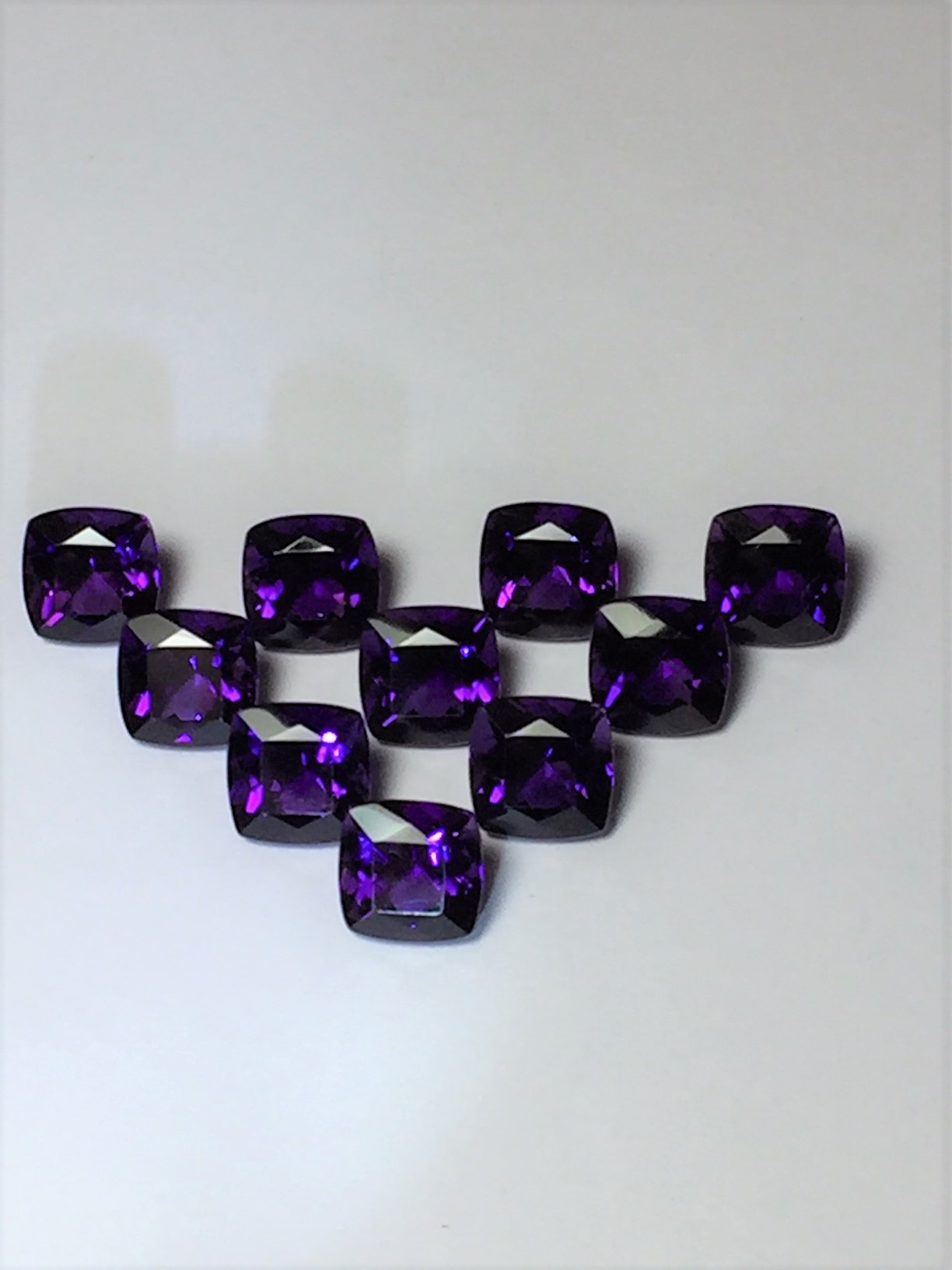
Adding to amethyst’s allure is its sensitivity to lighting. Under evening or incandescent light, a stone will tend toward a deeper, darker purple. In daylight or fluorescent light, the same stone will adopt cooler grayish-blue tones. Amethyst may also show color zoning, angular zones of darker to lighter color.
Amethyst in large sizes and rich, deep colors is rare and more costly. Below, you’ll find an amethyst necklace I saw at a recent AGTA Gemshow’s Smithsonian display. This necklace, created by Louis Comfort Tiffany circa 1915, is an example of art nouveau style. The 56 carat Siberian amethyst is delicately surrounded by an 18 kt gold setting of vines, leaves and berries. The amethyst’s deep purple color with red flashes makes the necklace both beautiful and valuable. It was donated to the Smithsonian in 2007 by June Resner and Russell Bilger.
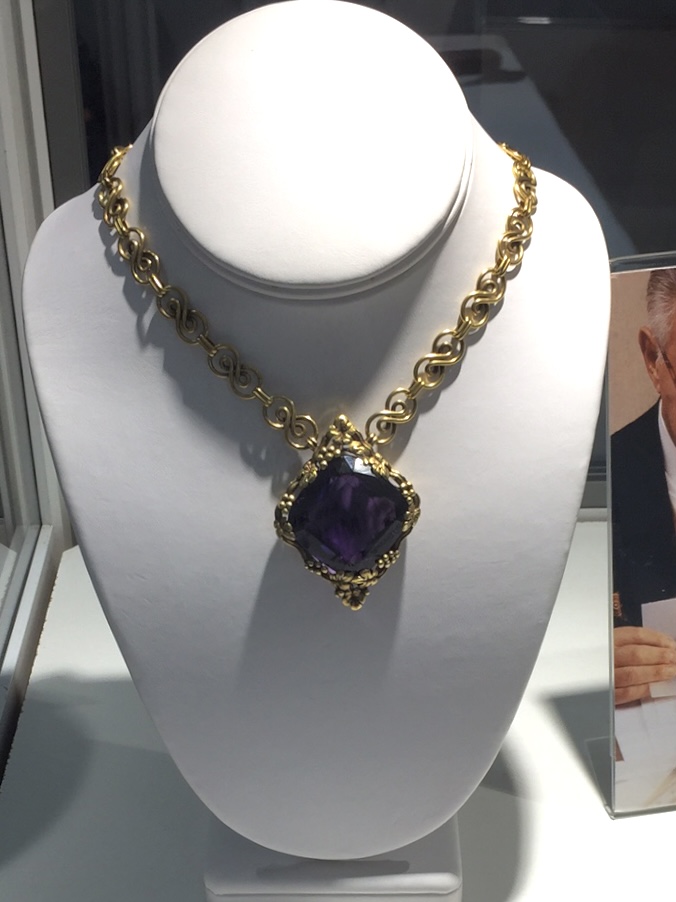
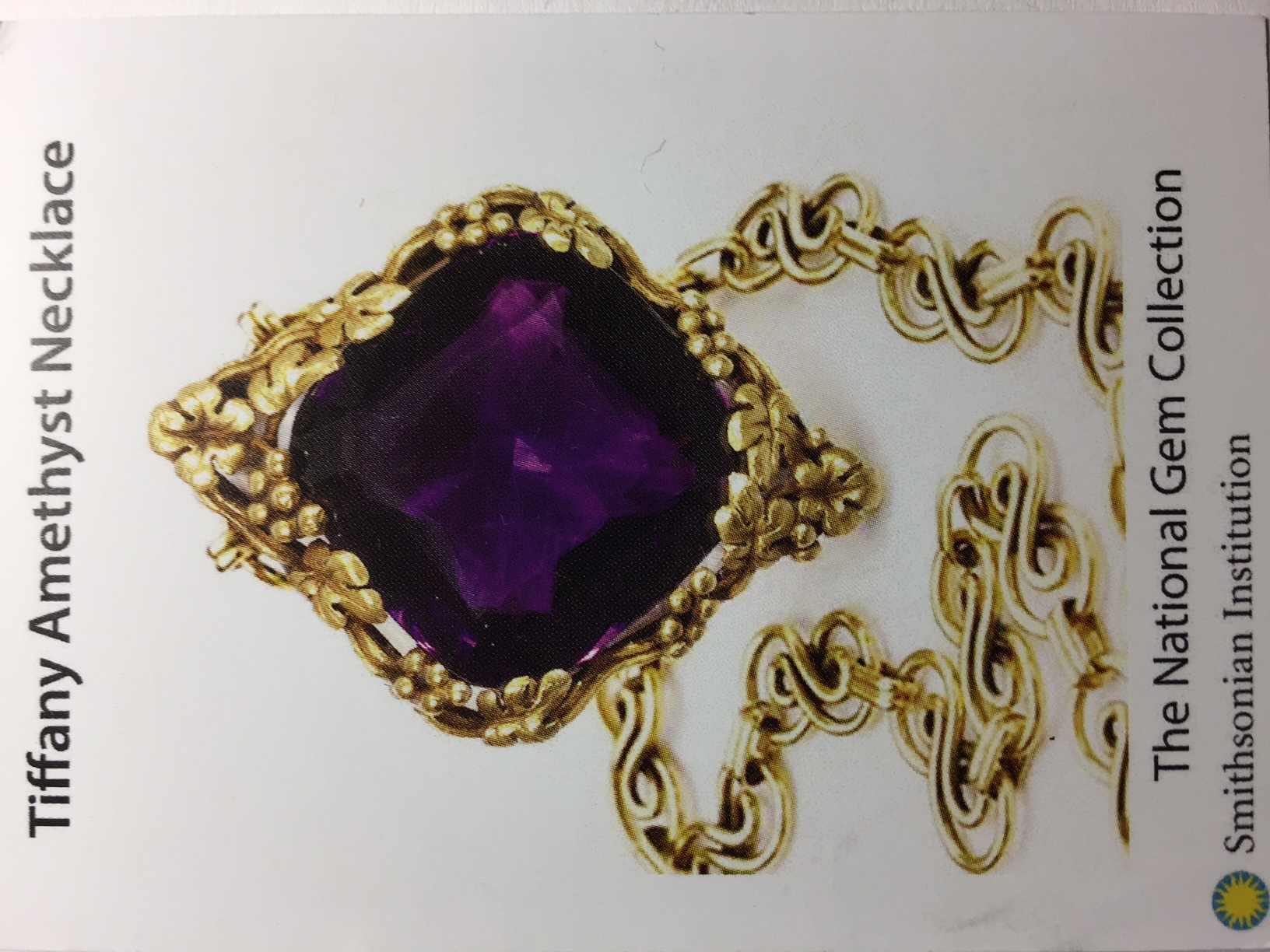
Amethyst, like any other popular gem, is imitated, treated and synthesized. The great majority of amethyst available today is either heat treated or irradiated to deepen and intensify its purple hues. These enhancements are permanent and will not fade over time. Irradiation is almost impossible to detect via conventional gem testing methods.
Although natural amethyst is readily available, it is also created synthetically. Largely as a bi-product of quartz synthesis for the electronic business, man-made amethyst can be found in the marketplace.
Amethyst Formation, Mining and Cutting
Three of the most popular transparent gem-quality quartz varieties - amethyst, citrine and smoky quartz - all start out as large crystals. Numerous amethyst rough deposits are being mined throughout the world with Brazil, Uruguay and Zambia being particularly important. Brazil remains one of the most significant producers of amethyst. Neighboring Uruguay produces less amethyst, but many consider its clarity and rich, dark color to be superior to Brazilian amethyst. Russian material is also prized for its rich color. It is not unusual for the finest colored amethyst in the market to be referred to as “Siberian Amethyst.” Zambia is another large global producer. Zambian amethyst is often small, but its dark color and clarity make it some of the finest in the world. Amethyst is mined throughout the United States – in Arizona, Texas, Pennsylvania, North Carolina, Maine and Colorado. The largest amethyst mine in North America is located in Thunder Bay, Ontario, Canada. Other sources of amethyst include India, Madagascar, Mexico, Argentina, Myanmar, Namibia, Sri Lanka and Tanzania.
In gem localities like Brazil, amethyst sometimes forms in hollow, crystal-lined geodes so big you can stand in them. I visited the Gemological Institute of America’s Carlsbad, California main campus and laboratory a number of times while obtaining my Graduate Gemologist certification. The lobby contains gemstone and jewelry-related displays. On one visit I got to see this strikingly unusual double geode:
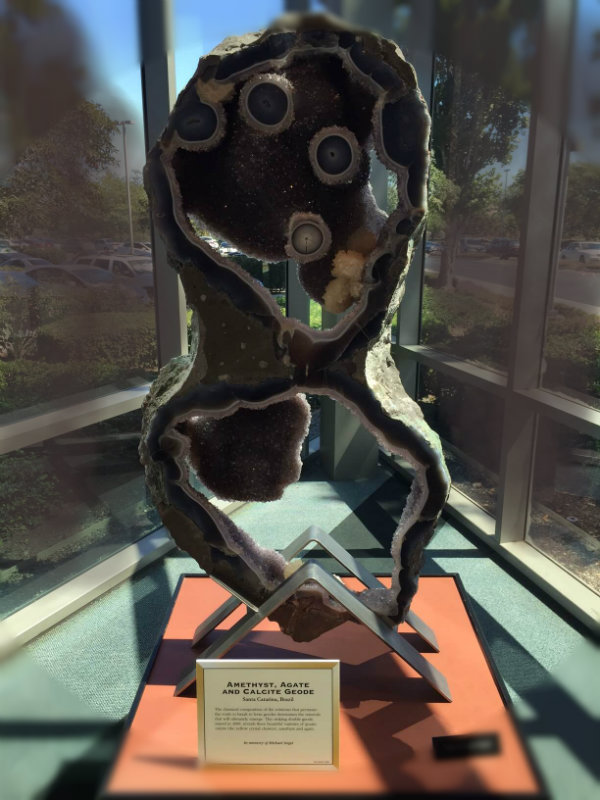
This beautiful specimen contains crystals of amethyst (the purple crystals), calcite (the yellow crystal clusters) and agate (the concentric circular shapes encompassed within the amethyst in the upper geode).
Another feature of amethyst is it can be found as very large, sometimes gigantic, crystals in nature. The GIA Museum once displayed a doubly terminated crystal weighing 164 pounds. Gems of all sizes are possible thanks to amethyst’s large, near flawless crystals. While not 164 pounds, at an AGTA Gemshow, I was able to see this lovely multi-crystal amethyst cluster:
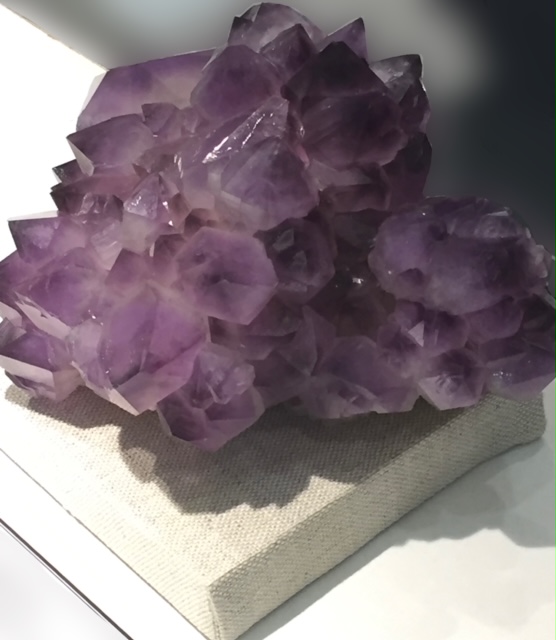
Heavily included amethyst with good color is often cut into cabochons or beads. While a cabochon does not produce a particularly brilliant affect, it is an effective way to showcase the stone’s color. Because of its abundance, lower quality amethyst is a popular gemstone for carving and beads. Amethyst crystals are particularly popular in the metaphysical world.
If you have a February birthday or purple is your color, click the link to browse the current 100 East Fine Jewelry Amethyst Collection. Some of our recent designs include these regal amethyst pieces:
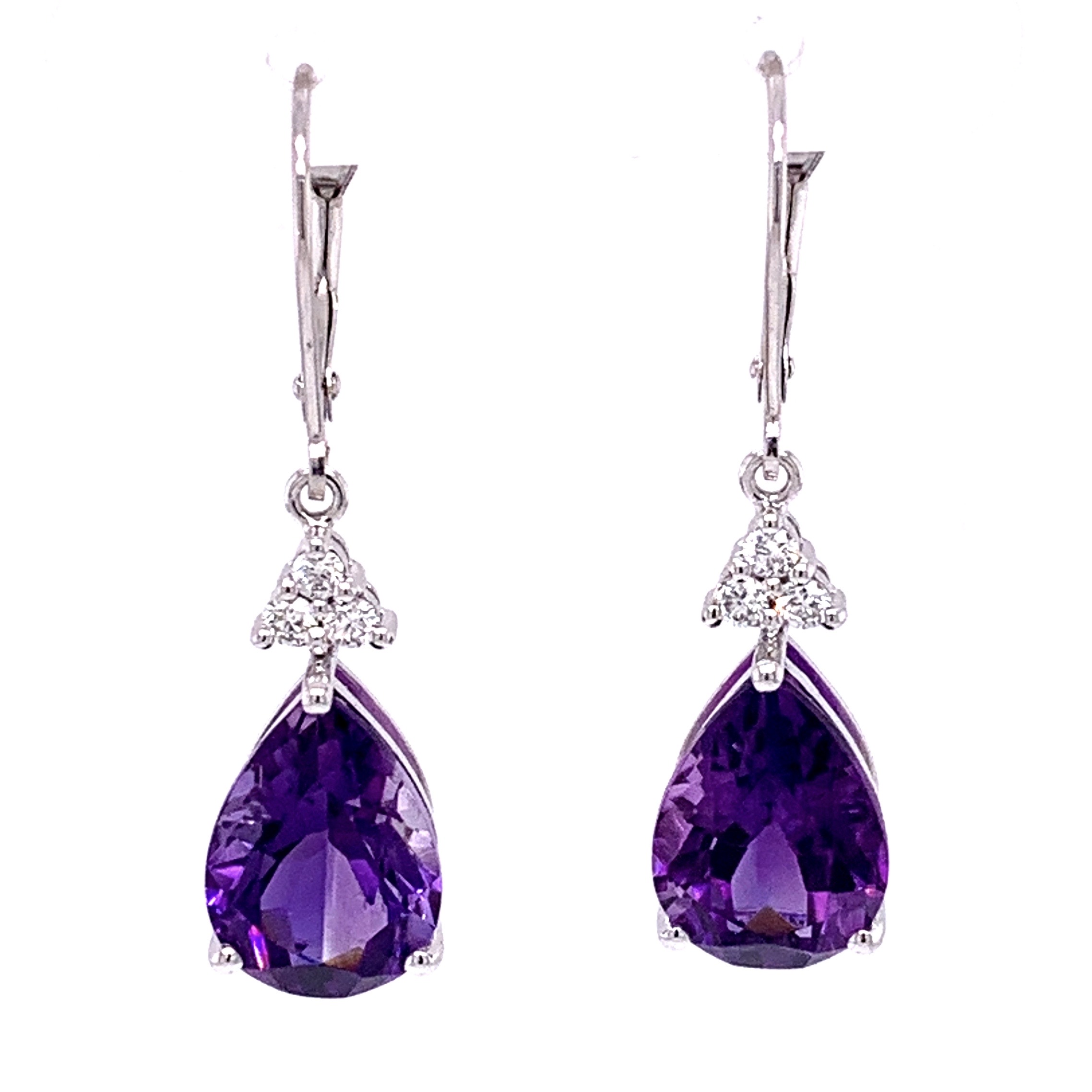
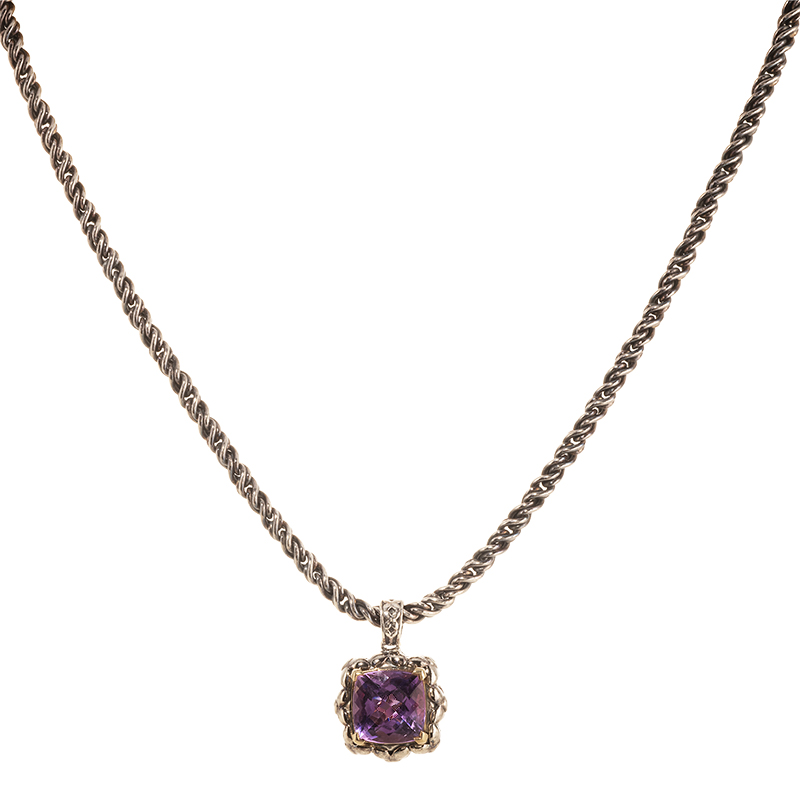
Credit: Gemological Institute of America, American Gem Trade Association and Gemworld International

